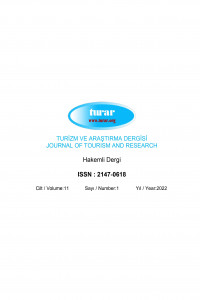Abstract
ÖZET
Bu araştırma Erzurum ilinin Uzundere ilçesinde yetişen yenilebilir yabani bitkileri tespit etmek ve gastronomik açıdan önemini belirlemek amacıyla planlanmış olup bu doğrultuda yürütülmüştür. Araştırmada nitel araştırma yöntemlerinden biri olan yarı yapılandırılmış görüşme tekniği kullanılmıştır. Araştırma esnasında Erzurum ili Uzundere ilçesinde ikametgâh eden yerel halkla görüşülerek bu bölgede yetişen yabani bitkilerden hangilerinin yenilebilir olduğu ve yenilebilen yabani bitkilerin kullanım amaçları hakkında bilgiler derlenmiştir. Görüşmeler esnasında literatür taraması sonucu hazırlanan sorulardan alınan cevaplar not tutularak, ses kaydı yapılarak ve fotoğraflanarak değerlendirilmiştir. Araştırma bölgesinde doğal olarak yetişen yenilebilir yabani bitkiler incelendiğinde yörede toplanan ve tüketilen 15 çeşit yenilebilir yabani bitkinin bulunduğu görülmüştür. Bu bitkilerin tamamı yiyecek amaçlı kullanılmakta olup, 13’ünün tıbbi amaçlı, 5’inin ticari amaçlı, 2’sinin sadece yeme amaçlı olduğu sonucuna ulaşılmıştır. Yörede yetişen bu bitkilere yöre halkı tarafından ilgi oldukça yoğundur. Yetişen bu bitkilerden yöre halkı genellikle sulu yemek ve kavurma yapmaktadır. Tıbbi amaçlı olanlardan özellikle çaşırın salamurası yapılarak tüketildiği, bitkilerden kış için de faydalanmak isteyenlerin evelik ve ısırgan bitkisini temiz bir bez üzerinde fazla güneş almayan yerlerde kurutarak sakladığı sonucuna ulaşılmıştır. Yine yörede yıl içerisinde hasadı tekrarlanan bitkilerden olan evelik, semizotu ve çaşır bitkisinin, çay için kurutulan kırmızı kuşburnunun, ipe dizilerek kurutulan alıç meyvesinin yöre halkı tarafından yol kenarlarında ve pazarlarda satıldığı sonucuna ulaşılmıştır. Elde edilen bu sonuç yörede yetişen yenilebilir yabani bitkilerin o yörenin kalkınmasına da katkı sağladığının bir göstergesidir.
ABSTRACT
In this study, it is aimed at identifying edible wild plants grown in Uzundere District of
Erzurum province and to determine its gastronomic importance and is carried out accordingly.
In the application part of the research, semi-structured interview technique, one of the
qualitative research methods, was used. During the research, the local people residing in
Uzundere district of Erzurum were interviewed and information about which of the wild plants
grown in this region are edible and the uses of edible wild plants were compiled. During the
interviews, the answers obtained from the questions prepared as a result of the literature review
were evaluated by taking notes, recording audio and photographing. When edible wild plants
grown naturally in the research area were examined, 15 types of edible wild plants collected
and consumed in the region were identified. All of these plants are used for food, 13 of them
are for medical purposes, 5 are for commercial purposes and 2 are for eating purposes only.
The interest of these plants grown in the region is very intense by the local people. Of these
plants grown, local people usually cook meals and roast. It has been concluded that those who
want to benefit from the plants for the winter, especially those that are used for medical
purposes, are made by using brine and dry the evil and nettle plant in a place where it does not
get much sun in a clean cloth. Again, it is concluded that evelik, purslane and çaşır, which are
among the plants whose harvests are repeated throughout the year, are sold on the roadside and
markets by the locals of the hawthorn fruit dried on a string. This result is an indication that
edible wild plants grown in the region also contribute to the development of that region.
Keywords: Edible Wild plants, Ethnobotanical, Gastronomy
Jel Codes: Q18
References
- Abdulrahaman, A. A., Fajemiroye, O. J. ve Oladele, FA. (2006). Ethnobotanical Study of Economic Trees: Uses of Trees as Timbers and Fuel Woods in Ilorin Emirate of Kwara State, Nigeria. Ethnobotanical Leaflets, 10: 113- 120.
- Akan, H. ve Bakır Sade, Y. (2015). Kahta (Adıyaman) Merkezi ve Narince Köyü’nün Etnobotanik Açıdan Araştırılması, BEÜ Fen Bilimleri Dergisi, 4(2), 219-248.
- Alpaslan, İ. (2011). Kuzeydoğu Anadolu’da Doğal Bitkilerden Yenilen ve Yemeklerde Kullanılanlar, III. Uluslararası Doğu Anadolu Bölgesi Geleneksel Mutfak Kültürü ve Erzurum Yemekleri Sempozyumu.
- Batu, S. (2000). Özel Gereksinimli Öğrencilerin Kaynaştırıldığı Bir Kız Meslek Lisesindeki Öğretmenlerin Kaynaştırmaya İlişkin Görüş Ve Önerileri. Eskişehir: Anadolu Üniversitesi Yayınları.
Abstract
References
- Abdulrahaman, A. A., Fajemiroye, O. J. ve Oladele, FA. (2006). Ethnobotanical Study of Economic Trees: Uses of Trees as Timbers and Fuel Woods in Ilorin Emirate of Kwara State, Nigeria. Ethnobotanical Leaflets, 10: 113- 120.
- Akan, H. ve Bakır Sade, Y. (2015). Kahta (Adıyaman) Merkezi ve Narince Köyü’nün Etnobotanik Açıdan Araştırılması, BEÜ Fen Bilimleri Dergisi, 4(2), 219-248.
- Alpaslan, İ. (2011). Kuzeydoğu Anadolu’da Doğal Bitkilerden Yenilen ve Yemeklerde Kullanılanlar, III. Uluslararası Doğu Anadolu Bölgesi Geleneksel Mutfak Kültürü ve Erzurum Yemekleri Sempozyumu.
- Batu, S. (2000). Özel Gereksinimli Öğrencilerin Kaynaştırıldığı Bir Kız Meslek Lisesindeki Öğretmenlerin Kaynaştırmaya İlişkin Görüş Ve Önerileri. Eskişehir: Anadolu Üniversitesi Yayınları.
Details
| Primary Language | Turkish |
|---|---|
| Subjects | Tourism (Other) |
| Journal Section | Research Article |
| Authors | |
| Publication Date | January 31, 2022 |
| Published in Issue | Year 2022 Volume: 11 Issue: 1 |


